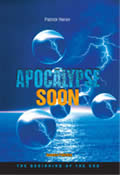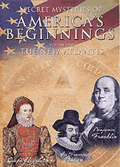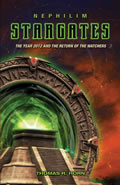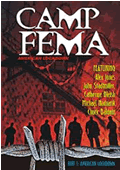PART 4
By Thomas R. Horn
August 18, 2010
NewsWithViews.com
OPEN SESAME!
There is a fifth dimension beyond that which is known to man. It is a dimension as vast as space and as timeless as infinity. It is the middle ground between light and shadow, between science and superstition, and it lies between the pit of man's fears and the summit of his knowledge. This is the dimension of imagination. It is an area which we call "The Twilight Zone." Rod Serling
In 1918,
famed occultist Aleister Crowley in attempting to discover how those evil
emissaries discussed in the last entry could be  extended
from their kosmos into man's reality undertook to create a magical vortex
that would span the gap between the world of the seen and the unseen.
Crowley's ritual was called the Amalantrah Working and according to his
records became successful when a presence manifested itself through the
rift. He called this being "Lam" and drew a portrait of it.
The startling image, detailed over ninety years ago, bears powerful similarity
with "alien greys" of modern pop culture.
extended
from their kosmos into man's reality undertook to create a magical vortex
that would span the gap between the world of the seen and the unseen.
Crowley's ritual was called the Amalantrah Working and according to his
records became successful when a presence manifested itself through the
rift. He called this being "Lam" and drew a portrait of it.
The startling image, detailed over ninety years ago, bears powerful similarity
with "alien greys" of modern pop culture.
Nearly three decades after the Amalantrah Working, rocket scientist and cofounder of the Jet Propulsion Laboratory, Jack Parsons and his pal L. Ron Hubbard (Church of Scientology founder) conducted a second ritual called the "Babylon Working" in an attempt to reopen Crowley's gateway. These men were not looking for Lam. They wanted to incarnate the Whore of Babylon—a demon child or gibborim—through a portal during ritual sex. Parsons wrote that the ceremony was successful and that at one point a brownish/yellow light came through the doorway and something invisible struck him, knocking a candle out of his hand.
It is interesting to note that following Crowley's magic portal (which allegedly produced the alien-looking Lam) and Hubbard and Parson's Babylon Working ritual, Crowley died in 1947—the same year as the Roswell crash and the same year Kenneth Arnold saw his flying saucers and sightings of "aliens" increased around the world. Some believe this is evidence that a demonic portal was indeed breached by these men. While we probably will never know if something truly supernatural happened with Crowley and Parsons, early Christians, as well as Hebrews, Assyrians, Greeks and other ancient cultures believed such dimensional gateways exist and can be opened between the material world and those entities discussed in part 3 of this series. Because physical doorways and windows on buildings were "mirrors" of the unseen gateways and were therefore vulnerable to entry by supernaturalism, those not interested in making contact with evil spirits placed magic gargoyles on their temples, churches, and castles to scare off and protect from harmful spirits, witches, and other malign influences seeking to manifest.
For instance, one of the most widely-used symbols by Greeks on their buildings was the terrifying Gorgon (such as Medusa), a horrifying female creature whose hair was made of venomous snakes and whose gaze could turn men to stone. To close the doorway to evil spirits in Babylon and Assyria, colossal enchanted creatures built under elaborate ceremonies and blessed by names of good omens flanked the palace entries and towering gates of cities while extra precaution was provided through winged figures holding magic devices cleverly concealed beneath the entryway floors. It was also important in ancient times to defend ones personal property and private residence against fiendish undesirables, therefore apotropaic (an adjective meaning "to ward off evil") devices were placed in home doorways, windows, fireplaces and chimneys, while charms, bracelets, and talismans were worn upon the body to protect the individual themselves.
The Hebrew prophet Ezekiel made an interesting statement about such "magic bracelets" (kesatot), which were worn upon the body and somehow bound spirits. We read, "Wherefore thus saith the Lord God; Behold I am against your pillows [kesatot, "magic bands"] wherewith ye there hunt the souls to make them fly, and I will tear them from your arms and will let the souls go, even the souls that ye hunt to make them fly" (Ezekiel 13:20). The kesatot was a magic arm band used in connection with a container called the kiste. Wherever the kiste is inscribed on sarcophagi, it is depicted as a vessel with a snake peering through an open lid. How the magic worked and in what way a spirit was bound or loosed is a mystery, but a noteworthy verification of the magical properties represented by these utilities is discussed in the scholarly work Scripture and Other Artifacts by Phillip King and Michael David:
In the closing verses of Ezekiel 13 the prophet turns his attention to magic practices whose details remain obscure. Two key terms are kesatot and mispabot…The kesatot are "sewn" on the arms, while the mispabot are made "on the head of every height" (?), which has been understood to mean "on the heads of persons of every height"…
In modern times archaeological discoveries and texts from Babylonia in particular have shed further light on what might be involved: G. A. Cooke cited Hellenistic figurines from Tell Sandahannah (Mareshah) in Palestine with wire twisted around their arms and ankles…and a magical text from Babylonia that speaks of white and black wool being bound to a person or to someones bed…J. Herrmann [notes] that both words can be related to Akkadian verbs, kasu and sapabu, which mean respectively "to bind" and "to loose"…Herrmann also drew attention to texts in which these verbs were used in a specifically magical sense…This indicates that, whatever the objects were, their function was to act as "binders" and "loosers" in a magical sense, in other words as means of attack and defense in sorcery. [1]
For people not familiar with the terms "binding" and "loosing," these staple words in spiritual warfare imply that certain influences can and should be "bound"—i.e. binding demons so that they cannot effect our minds, bodies, homes—while beneficial influences like good angels ought to be "loosed" (more on this in the final section).
Early religions and schools of mystery went into great detail about who and what was to be bound and loosed, including the advantages of how and why to do it. Beyond malevolent spirits in general, certain powerful entities that could suddenly "emerge" into man's reality were to be especially feared and avoided. These included Asmodai or Samael (the angel of death), Lilith, the mother of Ahriman and the queen of demons, Seir, a prince of hell with twenty-six legions of demons that could appear any place on earth, and thousands of others.
In Matthew 16: 17-19, Jesus directly tied the binding of such supernaturalism to the work of the ministry and the enduring power of his Church. To Peter he said, "upon this rock I will build my church; and the gates of hell shall not prevail against it. And I will give unto thee the keys of the kingdom of heaven; and whatsoever thou shalt bind on earth shall be bound in heaven: and whatsoever thou shalt loose on earth shall be loosed in heaven."
This deeply meaningful verse indicates something very important about gateways and openings, binding and loosing, who is to be bound, and the subsequent connection between this activity and the powers of heaven and earth. Note where Jesus says, "the gates of hell shall not prevail" against his Church. Putting the word "hell" in context here is very important because while the Greek word transliterated "Hades" was later confused with death and the grave (Thanatos [also see Rev. 1.18]), at the time Jesus chose to use this word he was possibly referring to the person of Hades or Pluto, the god of the lower regions, and Orcus, the nether world and realm of the dead. Why Jesus may have made reference to a Greek deity, combining it with the subjects of binding, loosing, gates, and spiritual warfare is important. The mythos of Hades and his connection to other deities and their ability to migrate between the spirit and physical world was dominant at the time of Christ, as his disciples would have been well versed, and Jesus may have intended for his followers to immediately connect the truth behind the struggle these living enemies represent to the children of God. Both the Old and New Testament make it clear that behind such pagan gods as Hades exists genuine personal evil that seeks to connect with and mislead mankind.
In Greek mythology, the correlation between Hades and the references of Jesus can be illuminated in the famous metaphor of the abduction and rape of Persephone (Proserpina), and of Demeter's (Persephone's mother) actions in searching for her daughter.
The myth claimed that Hades—the dark god of the underworld—fell in love with beautiful Persephone. One day as she plucked flowers in a grassy meadow, Hades swooped down in his chariot and dragged her down into the underworld, where he forced her to become his bride. Above ground, Demeter was distraught by her daughter's disappearance, and searched the earth in vain to find her. With the help of Helios and Hecate, Demeter finally discovered the truth of what happened, and, in her fury, demanded that Hades release her daughter. When Hades refused, Demeter sent a horrific famine upon the earth. Plants dried up; seeds refused to sprout, and the gods began to suffer from a lack of sacrifices. Finally, Zeus dispatched Hermes to intercede with the lord of the underworld, and, after a great debate, Hades agreed to release Persephone if she would eat a pomegranate seed. What Persephone did not understand was that, by eating the seed in the mystical location of the underworld, a sort of divine symmetry was created that bonded her with Hades. This ensured that the goddess would automatically return to the underworld for a third part of each year (in the winter), during which time the seeds of the ground would not grow.
Persephone thus became the upperworld goddess of youth and happiness, and the underworld queen of the dead; a dual role that depicted her as both good and evil. On earth she was the goddess of the young and the friend of the nymphs who appeared in the blooming of the spring flowers (symbolizing her annual return from Hades), and in the underworld she was the dreaded wife of Hades and the queen of the darkness who controlled the fates of deceased men. The reenactment of such myth—the abduction and rape of Persephone—was central to the famous rituals of the Thesmophoria, and, as such, key to interpreting the bits of information known about it.
The festival of the Thesmophoria—sometimes called the Eleusinian Mysteries—lasted between three and ten days. Each day of the festival had a different name and included specific rituals. A highlight of the festival was a procession from Athens to Eleusis which was led by a crowd of children known as ephebi. The ephebi assisted in carrying the hiera (sacred objects), and in pulling a statue of Dionysus as a boy (Iacchos), and finally in the ceremonial cleansing of the initiates (candidates of the mystery religion) in the sea. Upon arriving at Eleusis the women organized the first day of the celebration (anodos) by building temporary shelters and electing the leaders of the camp. On the second day (nesteia) they initiated the Greater Mysteries which, according to myth, produced the cult's magical requests (a fertile harvest). Such mysteries included a parody of the abduction and rape of Persephone, and the positioning of the female devotees upon the ground weeping (in the role of Demeter for her daughter) and fasting for the return of Persephone (the return of spring). The setting upon the ground and fasting was also intended to mystically transfer the "energies" of the women into the ground, and thus into the fall seeds.
Not surprisingly, the festival was held during the time of the fall planting so as to nearly guarantee a positive response to the cult's magic. On the fifth day of the festival the participants drank a special grain mixture called kykeon (a symbol of Persephone) in an attempt to assimilate the spirit of the goddess. About this same time certain women called "antleriai" were cleansed in the sea and then sent down into the mountainside trenches to recover the sacrificial piglets and various other sacred objects that had been thrown down into the hillside canyons several days earlier. The sacred objects included dough replicas of snakes and genitalia, which were burned with the piglets and a grain-seed-mixture as an offering to Demeter. While several mystical representations can be made of the symbolism, and the dough replicas are obviously fertility representations, pigs blood was sacred to the gods and thus the piglets are key to understanding the ritual. Greeks venerated pigs because of their uncanny ability to find, and unearth, underground items (roots, etc). Some scholars conclude from this that the ritual casting of the pigs "into the deep" was a form of imitative magic based on the underworld myth of Persephone and Hades. Casting the piglets into the deep canyon trenches, and fetching them back out again, represented the descent of Persephone into the underworld and her subsequent ascension back up to the surface of the earth.
The piglets in the trenches may have also served the practical purpose of supplying a host (body) for Persephone to hide in until the antleriai women could assist her (by retrieving the piglets) in her annual escape from the underworld. Burning the piglets later that night would, according to an ancient religious idea that fire passes the soul through a gateway from one location to another, free the spirit of Persephone into the upperworld (compare the children sacrificed to Baal who "passed through the fire" from the physical world into the spiritual in 2 Kings 23:10).
The New Testament informs us that such pagan rituals were the worship of demons. "The things which the Gentiles sacrifice," said Paul, "they sacrifice to devils..." (1 Corinthians 10:20). This makes one wonder if a connection between the ritual casting of the piglets down into the deep canyon trenches (representing a descent into hell), and the biblical story of the Gadarene demoniac, existed:
In Luke, chapter Eight, we read:
And they arrived at the country of the Gadarenes....And when he [Jesus] went forth to land, there met him out of the city a certain man, which had devils....When he [the demoniac] saw Jesus, he cried out, and fell down before him, and with a loud voice said, "What have I to do with thee, Jesus, thou Son of God most high? I beseech thee, torment me not"....And Jesus asked him, saying, "What is thy name?" And he said, "Legion:" because many devils were entered into him. And they besought him that he would not command them to go out into the deep [emphasis added]. And there was there an herd of swine [emphasis added] feeding on the mountain: and they besought him that he would suffer them to enter into them. And he suffered them. Then went the devils out of the man, and entered into the swine: and the herd ran violently down a steep place into the sea [emphasis added], and were choked. (Luke 8:26-33)
The word deep in this text is Abussos (the Abyss), and refers to the underworld Bottomless Pit. Since the principle elements of the sea, the swine, and the deep were employed; and since the Abyss (part of the underworld) was central to the narrative; and further since the cult rituals of the Thesmophoria were well known throughout Asia Minor and were considered by the Hebrews to be activity of the devil (the inhabitants of Hades were known as 'Demeter's people,' and Hecate, the goddess of witchcraft, was Perserphone's underworld guide during the rituals); one could easily surmise that Jesus was mocking the Thesmophoria. It's possible that Jesus was revealing, to his followers and to the neighboring communities, that such rituals of Dionysus and of Demeter were, in fact, the consort of devils.
| Subscribe to the NewsWithViews Daily News Alerts! |
It may be a stretch to suggest an interpretation of the biblical story in this way, but clearly the similarities and historical proximities are startling, especially since the demons requested entry into the swine. Why would demons make such a plea? There are two possible connections with the Thesmophoria: 1) the demons believed that by entering the swine they could escape the underworld deep (as in the magical Persephone escape ritual described above); and 2) Jesus, by granting the request of the devils, was illustrating that the Thesmophoria ritual of casting the piglets into the deep was inherently demonic. Obviously there are other possible interpretations of the narrative in Luke chapter eight, but since this is the only record of Jesus granting the petition of demons, it seems reasonable that a powerful social commentary about spiritual warfare was made by the Master.
But there is deeper truth about these underworld deities, which we will "dig" into in the next entry...
[Editor's note: This series is based on research contained in Tom and Nita Horn's upcoming new book: Forbidden Gates: How Genetics, Robotics, Artificial Intelligence, Synthetic Biology, Nanotechnology, & Human Enhancement Herald the Dawn of Techno-Dimensional Spiritual Warfare.]
Sign up to be notified when the book on which this series is based is released and receive OVER $60.00 IN FREE GIFTS! Sign up here!
Click here for part -----> 1, 2, 3,
� 2010 Thomas Horn - All Rights Reserved
Sign
Up For Free E-Mail Alerts
E-Mails are used strictly for
NWVs alerts, not for sale
Thomas Horn is the CEO of RaidersNewsNetwork.com and SurvivorMall.com.
Over the last decade, he has authored three books, wrote dozens of published editorials, and had several feature magazine articles. In addition to past articles at NewsWithViews.com , his works have been referred to by writers of the LA Times Syndicate, MSNBC, Christianity Today, Coast to Coast, World Net Daily, White House Correspondents and dozens of newsmagazines and press agencies around the globe. Tom's latest book is "The Ahriman Gate," which fictionalizes the use of biotechnology to resurrect Biblical Nephilim.
Thomas is also a well known radio personality who has guest-hosted and appeared on dozens of radio and television shows over the last 30 years, including "The 700 Club" and "Coast to Coast AM." When looking for a spokesperson to promote their film "Deceived" staring Louis Gossett Jr. and Judd Nelson, "Cloud 10 Pictures" selected Thomas as their spokesperson to explain the Christian viewpoint on UFO-related demonology.
Web Site: RaidersNewsNetwork.com
E-Mail: RaidersNewsUpdate@gmail.com














 Share
This Article
Share
This Article







